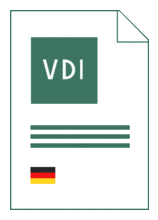
Technical rule [WITHDRAWN]
VDI 3404:2009-12
Additive fabrication - Rapid technologies (rapid prototyping) - Fundamentals, terms and definitions, quality parameters, supply agreements
- German title
- Generative Fertigungsverfahren - Rapid-Technologien (Rapid Prototyping) - Grundlagen, Begriffe, Qualitätskenngrößen, Liefervereinbarungen
- Publication date
- 2009-12
- Original language
- German, English
- Pages
- 48
- Publication date
- 2009-12
- Original language
- German, English
- Pages
- 48
Product information on this site:
Quick delivery via download or delivery service
Buy securely with a credit card or pay upon receipt of invoice
All transactions are encrypted
Short description
Additive fabrication/rapid technologies are an inherent part of the product development process. They are used to manufacture prototypes, tools and production parts. In addition to engineering, the scope of this interdisciplinary technology now covers fields ranging from architecture and medicine to archaeology and cartography. During its somewhat turbulent development, different terms and definitions have emerged which are frequently ambiguous and confusing. Moreover, there are various different processes available on the market and it is not always clear what opportunities and limitations they offer in terms of application. This guideline aims to offer fieldtested recommendations and advice to users (customers) and manufacturers (both external and internal service providers), to improve communication between customer and supplier and to contribute to an authoritative performance design and a smooth handling of the project. The guideline - differentiates between additive and conventional processes, - acilitates improved assessment of different additive processes, - specifies the quality parameters of different processes, - specifies appropriate test procedures, - recommends the scope and content of - tests and - supply agreements. This guideline applies wherever additive processes are used, and to the following fields in particular: - production of additive fabrication systems and equipment including software - material development and distribution - additive fabrication of parts, tools and end products - use of these parts, tools and end products.
Content
ICS
25.020
Replacement amendments
This document has been replaced by: VDI 3405:2014-12 .
Also available in
Loading recommended items...
Loading recommended items...
Loading recommended items...

